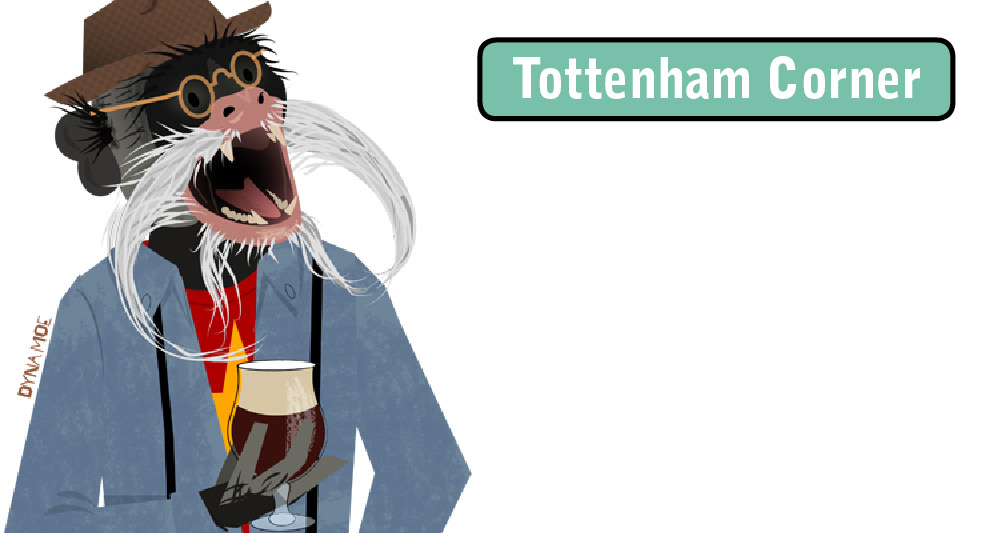I had serious work to do, so I took a nap. After dragging it out for as long as possible, I rolled off the sofa and quickly went out, greatly in need of some revivifying fresh air, or air as fresh as it gets around here. Ten minutes later I walked into what passes for a neighborhood beer parlor in this day and age: a cross between a wine bar and a rec room, where hundreds of obscure craft ales are available.
Happy Hour was in session. Beady-eyed beer lovers fondled their precious microbrews. I selected a can of Old Speckled Hen and sunk into a comfortable leather armchair. Patrons walked in with their dogs and bicycles. To my right, two businessmen disguised as “hipsters” blatted about “marketing.” “We’ll cross that bridge when we come to it,” one of them said. Evidently, they were discussing the takeover of a local business. To my left, a cyclist in shorts stroked his muscular tattooed leg and leaned over to converse with a muscular, heavily tattooed woman in shorts. Her every “like”-linked statement was met with a “cool” or “awesome” by her ardent interlocutor. Hey “guys,” if we just keep saying “cool” and “awesome” and address each other—even women—as “guys” (so cloying and pandering this nauseatingly ubiquitous form of address with its insidiously reassuring ring of homogenizing inclusivity), we can maintain the illusion that everything is cool and awesome and not really care about anything. And while we’re at it, dumb up the volume, because if you turn it down the quality of conversation will have to rise.
Also, take note that if one is alone in a public place it is compulsory to fiddle with a gadget of some sort, to shrink the world into a tiny all-purpose hand-held device that promotes the illusion that one isn’t really alone—that one has stuff going on. It is no longer possible to just sit there. Abstraction has been outlawed by technology.
The “old-school punk” on the sound system—The Buzzcocks’ “I Don’t Know What To Do With My Life”—seemed at odds with the atmosphere of loud but mellow complacency. Less time went by between the end of World War II and the first punk campaign than has now passed between that era of stripped-down urgency and this dried up age of abundance, yet the music of 35 years ago—and earlier—lives on as a gold standard to young people (hell, it’s not as if kids in the ’70s were grooving to Glenn Miller) and seems to mean more to them than the music of their own time. Authenticity is a thing of the past. Vicarious nostalgia is a symptom of it. And the past is paste, holding a splintered world together. As has been persuasively argued by Camille de Toledo in “Coming of Age at the End of History,” the only way to be radical in this day and age is to be invisible. Not that anybody’s interested in being radical… or invisible.
And in the palpable absence of radical invisibility, this is a perfectly pleasant watering hole with a tantalizing selection of brews. One would have to be a very unpleasant person to find fault with it. But I am, and I do. Maybe because it’s too nice: all flannel shirts, facial hair and weak-voiced mangling of the English language. It is symptomatic of the Portlandization of Los Angeles.
When I had the misfortune of living in Portland for a brief spell in the ’90s it seemed a unique place, a tight white pocket of bohemian conformity where the “alternative” was the norm and genuine eccentricity wasn’t tolerated; “Embrace Diversity” bumper stickers abounded but blacks were outnumbered by dreadlocked whites. From what I understand, it is worse now, but the disease of alternative normality has spread, even as far as LA—a place of disaffection, dislocation and reinvention that was once despised by Northwesterners and, indeed, everyone else.
I attended a show in Portland some years ago and when the performer announced that he was headed for Los Angeles the next day the entire crowd erupted in booing. It filled me with pride. One of the nicest things about being an Angeleno has always been that once you get beyond the city limits nothing but disdain is directed this way. It’s fun to live in a city that people from other cities regard as the enemy and even expect you to apologize for living in. San Franciscans and Portlanders, in particular, seem to regard it as their civic duty to hate LA and everything it apparently stands for, although, curiously, the feeling is not reciprocated. Which is why it’s so unsettling to find that nowadays there’s not much difference between certain neighborhoods of this city and Portland.
It happened slowly. Fifteen years ago it was uncommon to see a fresh-faced white guy on the Echo Park stretch of Sunset or on York Blvd in Highland Park, especially after dark. Now every block is swarming with them, with all the essential accessories perfectly aligned: facial hair, tattoos, girlfriend, smartphone, dog—babies are optional, meanwhile the dog serves to signify an aspiring breeder. What was once the mark of the renegade is now a badge of conformity, a declaration of redundancy. That’s the way it has always gone. Things change. So what? Because sometimes, for various petty and perverse reasons, it can be disconcerting to observe things gradually changing. Of course, there’s nothing wrong with it at all, it’s not a problem, not in the least; nothing remotely bad about it. Maybe that’s the problem.


